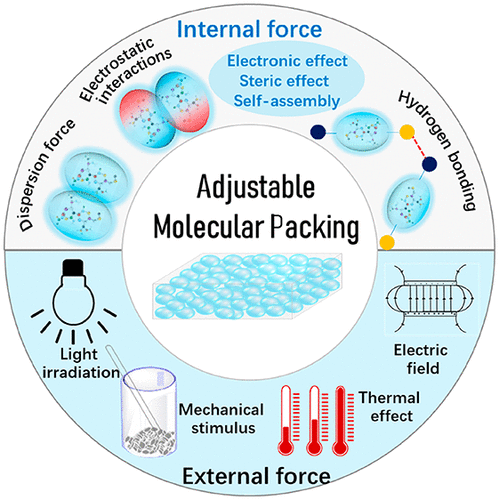当前位置:
X-MOL 学术
›
Acc. Chem. Res.
›
论文详情
Our official English website, www.x-mol.net, welcomes your
feedback! (Note: you will need to create a separate account there.)
Molecular Packing: Another Key Point for the Performance of Organic and Polymeric Optoelectronic Materials.
Accounts of Chemical Research ( IF 16.4 ) Pub Date : 2020-04-03 , DOI: 10.1021/acs.accounts.0c00060 Qianqian Li 1 , Zhen Li 1, 2
Accounts of Chemical Research ( IF 16.4 ) Pub Date : 2020-04-03 , DOI: 10.1021/acs.accounts.0c00060 Qianqian Li 1 , Zhen Li 1, 2
Affiliation

|
ConspectusOptoelectronic material properties are governed by the whole collective of organic moieties, and these aggregate states present the characteristic performance of extended assemblies with different molecular packing, not only of single molecules themselves. Thus, controlling molecular packing is an essential issue for obtaining the optimized optical and electronic properties. It is also a great challenge because of the unclear structures and complicated intermolecular interactions, including dispersion forces, electrostatic interactions and hydrogen bonding. Moreover, upon the introduction of some external force as the stimulus source, dynamic optical properties can be achieved with the transformation of molecular packing in some cases, such as the photoinduced room temperature phosphorescence (RTP) effect, mechanochromic luminescence, the thermal treatment-dependent mechanoluminescence effect, and the optimized nonlinear optical (NLO) property achieved after electric poling. Therefore, it is essential to understand the relation between characteristics of molecular packing and the resultant optoelectronic performance at the molecular level, which becomes increasingly demanding for the further development of functional materials for their applications in organic light-emitting diodes (OLEDs), chemo- and biosensors, organic solar cells, data storage, and anticounterfeiting devices.This Account gives a summary of our research on the molecular design of optoelectronic materials, with the consideration of a molecular uniting effect in different aggregated states, such as crystalline states, thin films, and nanoparticles. Through the systematical investigation of structure-packing-performance relationships, some strategies are afforded to partially control the molecular packing via the tunable size, shape, and configuration of aromatic moieties with different electronic and steric effects, together with different types of substituents as functional units to adjust the intermolecular interactions. The utilization of π-π interactions and hydrogen bonding by rational molecular design is considered as the key point to achieve the bright emission of organic materials, including the RTP and mechanoluminescence effects. Also, the dynamic optoelectronic properties are highlighted with different kinds of stimuli, including light irradiation, mechanical force, thermal treatment, and electric field, which are mainly related to the subtle molecular motions under external force and the changeable molecular packing as the metastable state. These selected examples will not only open a window for further development of organic and polymeric optoelectronic materials by the adjustable molecular packing and noncovalent interactions, but also prompt further advances for more interesting and exciting properties.
中文翻译:

分子堆积:有机和高分子光电材料性能的另一个关键点。
Conspectus光电材料的性能由有机部分的整体决定,这些聚集态表现出具有不同分子堆积的扩展组件的独特性能,而不仅仅是单个分子本身。因此,控制分子堆积是获得最佳光学和电子性能的基本问题。由于结构不清楚和复杂的分子间相互作用(包括分散力,静电相互作用和氢键),这也是一个巨大的挑战。此外,在引入一些外力作为刺激源后,在某些情况下可以通过改变分子堆积来实现动态光学特性,例如光致室温磷光(RTP)效应,机械变色发光,取决于热处理的机械发光效应,以及电极化后获得的优化的非线性光学(NLO)特性。因此,有必要了解分子堆积特性与分子水平上的光电性能之间的关系,这对于功能材料在有机发光二极管(OLED)中的应用越来越要求进一步开发。以及对生物材料,有机太阳能电池,数据存储和防伪设备的研究。此帐户总结了我们在光电子材料分子设计方面的研究,并考虑了在不同聚集态(例如晶体态,薄膜)的分子结合效应和纳米粒子。通过对结构-填充-性能关系的系统研究,提供了一些策略,通过具有不同电子和空间效应的芳香族部分的可调大小,形状和构型,以及不同类型的取代基作为功能单元,部分控制分子的堆积调整分子间的相互作用。通过合理的分子设计利用π-π相互作用和氢键被认为是实现有机材料亮发射的关键,包括RTP和机械发光效应。此外,动态光电子特性会通过不同种类的刺激来突出显示,包括光辐射,机械力,热处理和电场,这主要与外力作用下的微妙分子运动和亚稳状态下分子堆积的变化有关。这些选定的例子不仅将为通过可调节的分子堆积和非共价相互作用进一步开发有机和高分子光电材料打开一扇窗,而且还将促使其进一步发展以获得更有趣和令人兴奋的特性。
更新日期:2020-04-23
中文翻译:

分子堆积:有机和高分子光电材料性能的另一个关键点。
Conspectus光电材料的性能由有机部分的整体决定,这些聚集态表现出具有不同分子堆积的扩展组件的独特性能,而不仅仅是单个分子本身。因此,控制分子堆积是获得最佳光学和电子性能的基本问题。由于结构不清楚和复杂的分子间相互作用(包括分散力,静电相互作用和氢键),这也是一个巨大的挑战。此外,在引入一些外力作为刺激源后,在某些情况下可以通过改变分子堆积来实现动态光学特性,例如光致室温磷光(RTP)效应,机械变色发光,取决于热处理的机械发光效应,以及电极化后获得的优化的非线性光学(NLO)特性。因此,有必要了解分子堆积特性与分子水平上的光电性能之间的关系,这对于功能材料在有机发光二极管(OLED)中的应用越来越要求进一步开发。以及对生物材料,有机太阳能电池,数据存储和防伪设备的研究。此帐户总结了我们在光电子材料分子设计方面的研究,并考虑了在不同聚集态(例如晶体态,薄膜)的分子结合效应和纳米粒子。通过对结构-填充-性能关系的系统研究,提供了一些策略,通过具有不同电子和空间效应的芳香族部分的可调大小,形状和构型,以及不同类型的取代基作为功能单元,部分控制分子的堆积调整分子间的相互作用。通过合理的分子设计利用π-π相互作用和氢键被认为是实现有机材料亮发射的关键,包括RTP和机械发光效应。此外,动态光电子特性会通过不同种类的刺激来突出显示,包括光辐射,机械力,热处理和电场,这主要与外力作用下的微妙分子运动和亚稳状态下分子堆积的变化有关。这些选定的例子不仅将为通过可调节的分子堆积和非共价相互作用进一步开发有机和高分子光电材料打开一扇窗,而且还将促使其进一步发展以获得更有趣和令人兴奋的特性。











































 京公网安备 11010802027423号
京公网安备 11010802027423号